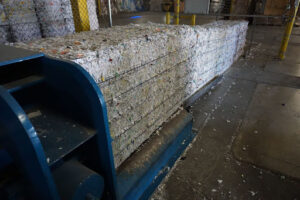Pre-pandemic, the global shipping industry wasn’t a big topic of conversation at parties. But once people stuck at home during quarantine started online shopping and the shipping container shortage began, global shipping and supply chain logistics became things everyone talks about. Clogged shipping ports, staffing shortages and skyrocketing prices for space on shipping containers have translated into higher prices and long delays for consumers who do business with international buyers or sellers.
The ups and downs of the global shipping industry are nothing new to recyclers. Exporting recyclable waste has long been a profitable way for American companies to manage materials that are technically recyclable, but that are too expensive or difficult to process and use again. Styrofoam, for example, is a number 6 plastic and can theoretically be melted down and turned into a new product, but few recycling facilities have a cost-effective way of doing that. Loading recyclables onto container ships and sending them to buyers in Asia has been standard practice for recycling exporters. That’s become more challenging recently because of two significant obstacles.
National Sword and Global Shipping Challenges in 2022
 For decades, China was the primary destination for shipments of American recyclables. Then China enacted its National Sword policy and stopped importing contaminated and low-grade materials. Other nations including Malaysia and India stepped in as customers for some of the materials that China stopped accepting.
For decades, China was the primary destination for shipments of American recyclables. Then China enacted its National Sword policy and stopped importing contaminated and low-grade materials. Other nations including Malaysia and India stepped in as customers for some of the materials that China stopped accepting.
So, while National Sword was a major blow to recycling exporters, the industry was adjusting to the changes it created when the pandemic began and the global shipping situation became so complicated. The problem now is getting shipments of recyclables onto ships bound for Asia. The demand for products being shipped from China means that it’s often more profitable for Asian exporters to bring container ships back from the U.S. empty and quickly fill them with more goods than it is for them to wait for their ships to be loaded with American exports. Since shipments of recyclables generally have relatively low value compared to loads of electronics or other pricy goods, they’re not being treated as high priority amid the global shipping crisis. Recycling exporters report that their shipments are among the first bumped whenever a ship is overly full.
Unfortunately, there’s little that recyclers or anyone else can do about the shipping mess other than wait and hope that things start to normalize over the next year. But it’s not all bad news for the recycling industry right now.
The Upside of National Sword: Creating Cleaner Materials
While National Sword forced a big shift, the recycling industry has largely recovered in the last few years. One piece of good news is that commodity values are up. We saw great demand for paper, plastic, metal and other recyclables in 2021. According to the Solid Waste Association of North America, in New England the average value for one ton of recyclables rose by 160 percent between summer 2019 and summer 2021.
We’ve also seen tremendous demand and high prices for recycled fiber since National Sword, especially within China. The country stopped importing fiber starting on January 1, 2020, which left Chinese manufacturers that make recycled paper products with limited options for sourcing materials. China still imports pulp, which is just fibers that have already been processed and cleaned. So now, countries like Taiwan and India are buying fiber, turning it into pulp and selling it to Chinese importers—who have to pay top dollar for the material since supply is so low.
Another upside of National Sword? China’s refusal to accept low-grade materials has also forced a national conversation about how to expand domestic recycling and create cleaner materials. Recycling facilities and exporters have cracked down on contamination, raising their standards for what kind of materials they’ll buy. The EPA has even weighed in, releasing its first-ever National Recycling Strategy in November 2021.
Subtitled “Part One of a Series on Building a Circular Economy for All,” the strategy includes five key objectives, including “improve markets for recycled commodities” and “reduce contamination in the recycled materials stream.” For businesses that want to do their part to expand recycling, actions recommended by the EPA include investing in recycling infrastructure (like bringing in recycling equipment such as balers) and creating clear and consistent signage for recycling containers and trash bins.
Moving into 2022, the general feeling within the recycling industry is that National Sword will have a positive long term impact by forcing the creation of cleaner materials. Exactly how that’s going to be done, we don’t know yet—but I’ll keep you posted as new developments unfold.
Miller Recycling is here to meet all our clients’ recycling needs, including keeping them informed about industry updates. How can we help your business streamline its recycling processes? Contact me today.

